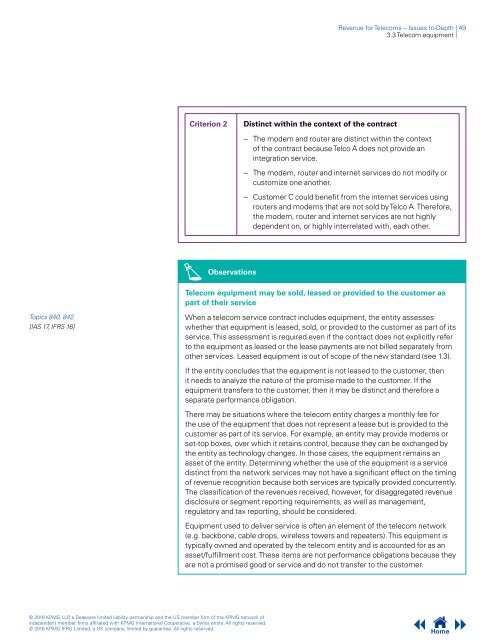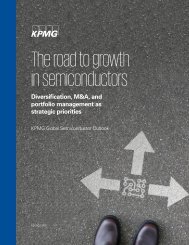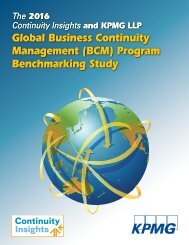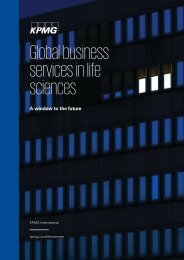Revenue for Telecoms
2cdncba
2cdncba
Create successful ePaper yourself
Turn your PDF publications into a flip-book with our unique Google optimized e-Paper software.
<strong>Revenue</strong> <strong>for</strong> <strong>Telecoms</strong> – Issues In-Depth | 49<br />
3.3 Telecom equipment |<br />
Criterion 2<br />
Distinct within the context of the contract<br />
– The modem and router are distinct within the context<br />
of the contract because Telco A does not provide an<br />
integration service.<br />
– The modem, router and internet services do not modify or<br />
customize one another.<br />
– Customer C could benefit from the internet services using<br />
routers and modems that are not sold by Telco A. There<strong>for</strong>e,<br />
the modem, router and internet services are not highly<br />
dependent on, or highly interrelated with, each other.<br />
Observations<br />
Telecom equipment may be sold, leased or provided to the customer as<br />
part of their service<br />
Topics 840, 842<br />
[IAS 17, IFRS 16]<br />
When a telecom service contract includes equipment, the entity assesses<br />
whether that equipment is leased, sold, or provided to the customer as part of its<br />
service. This assessment is required even if the contract does not explicitly refer<br />
to the equipment as leased or the lease payments are not billed separately from<br />
other services. Leased equipment is out of scope of the new standard (see 1.3).<br />
If the entity concludes that the equipment is not leased to the customer, then<br />
it needs to analyze the nature of the promise made to the customer. If the<br />
equipment transfers to the customer, then it may be distinct and there<strong>for</strong>e a<br />
separate per<strong>for</strong>mance obligation.<br />
There may be situations where the telecom entity charges a monthly fee <strong>for</strong><br />
the use of the equipment that does not represent a lease but is provided to the<br />
customer as part of its service. For example, an entity may provide modems or<br />
set-top boxes, over which it retains control, because they can be exchanged by<br />
the entity as technology changes. In those cases, the equipment remains an<br />
asset of the entity. Determining whether the use of the equipment is a service<br />
distinct from the network services may not have a significant effect on the timing<br />
of revenue recognition because both services are typically provided concurrently.<br />
The classification of the revenues received, however, <strong>for</strong> disaggregated revenue<br />
disclosure or segment reporting requirements, as well as management,<br />
regulatory and tax reporting, should be considered.<br />
Equipment used to deliver service is often an element of the telecom network<br />
(e.g. backbone, cable drops, wireless towers and repeaters). This equipment is<br />
typically owned and operated by the telecom entity and is accounted <strong>for</strong> as an<br />
asset/fulfillment cost. These items are not per<strong>for</strong>mance obligations because they<br />
are not a promised good or service and do not transfer to the customer.<br />
© 2016 KPMG LLP, a Delaware limited liability partnership and the US member firm of the KPMG network of<br />
independent member firms affiliated with KPMG International Cooperative, a Swiss entity. All rights reserved.<br />
© 2016 KPMG IFRG Limited, a UK company, limited by guarantee. All rights reserved.<br />
Home


